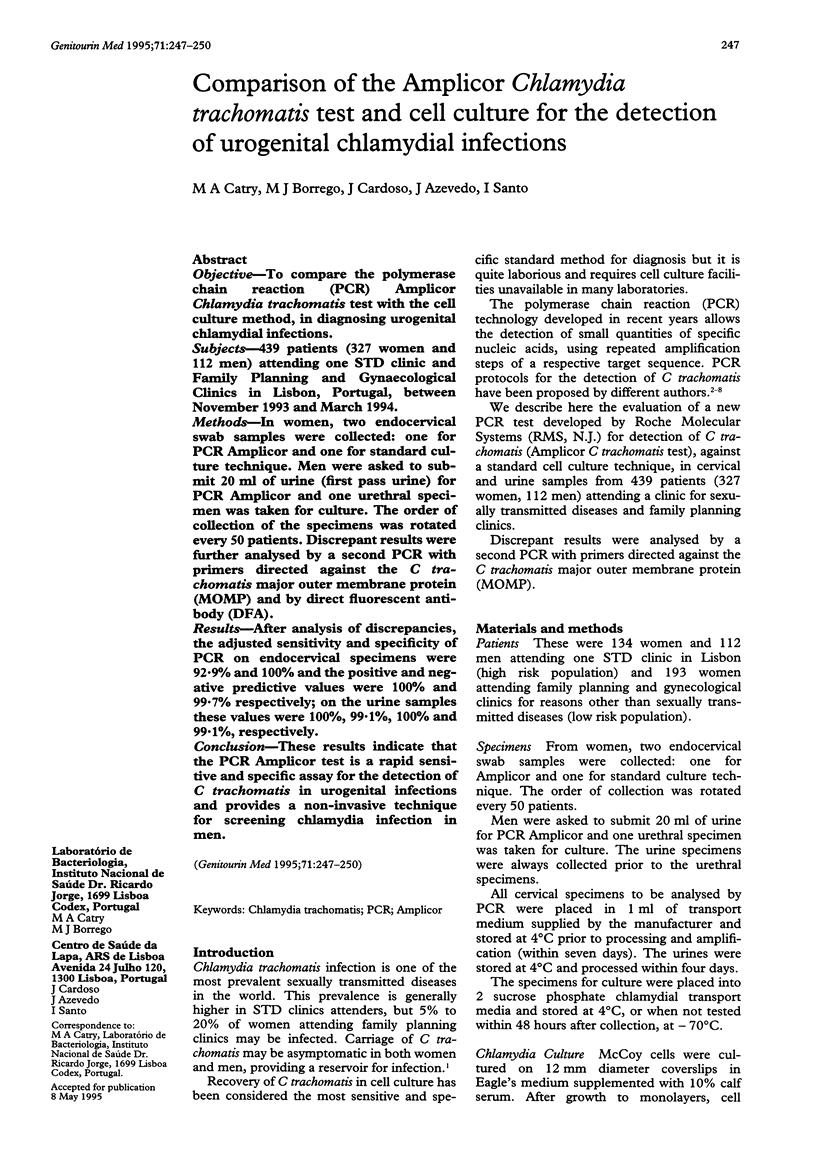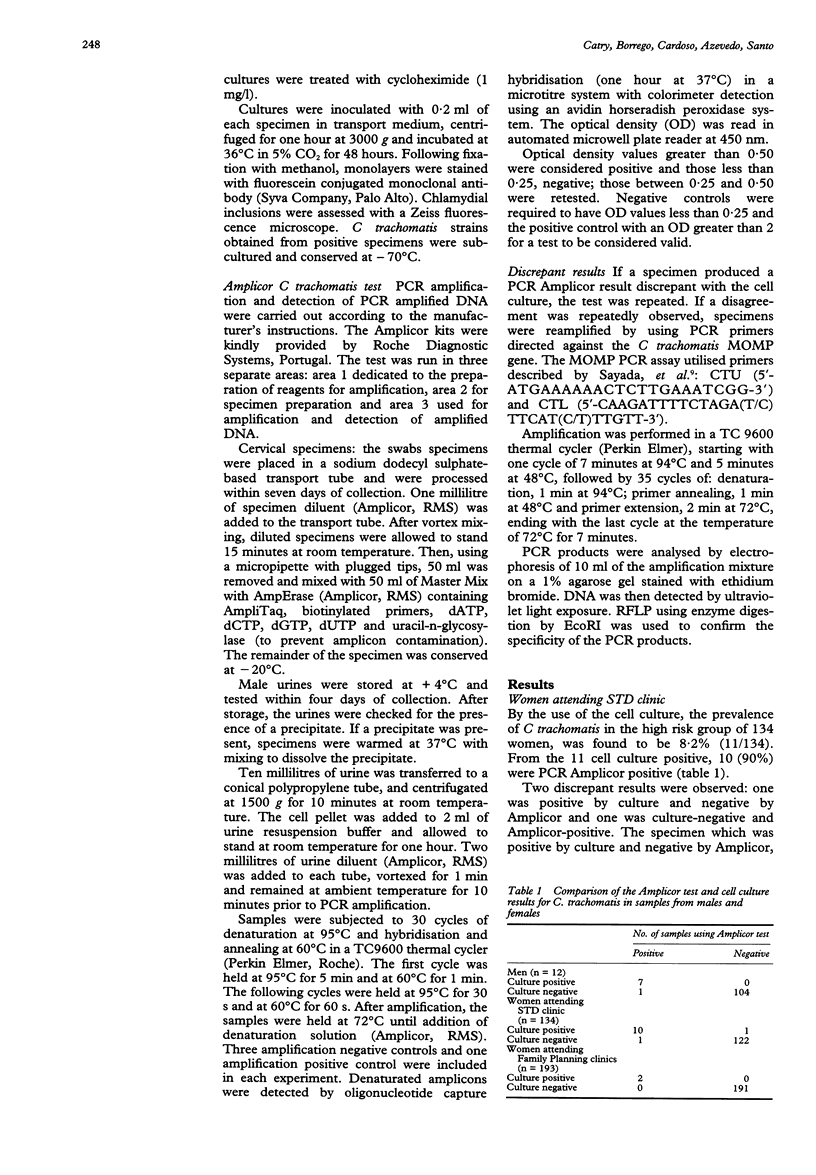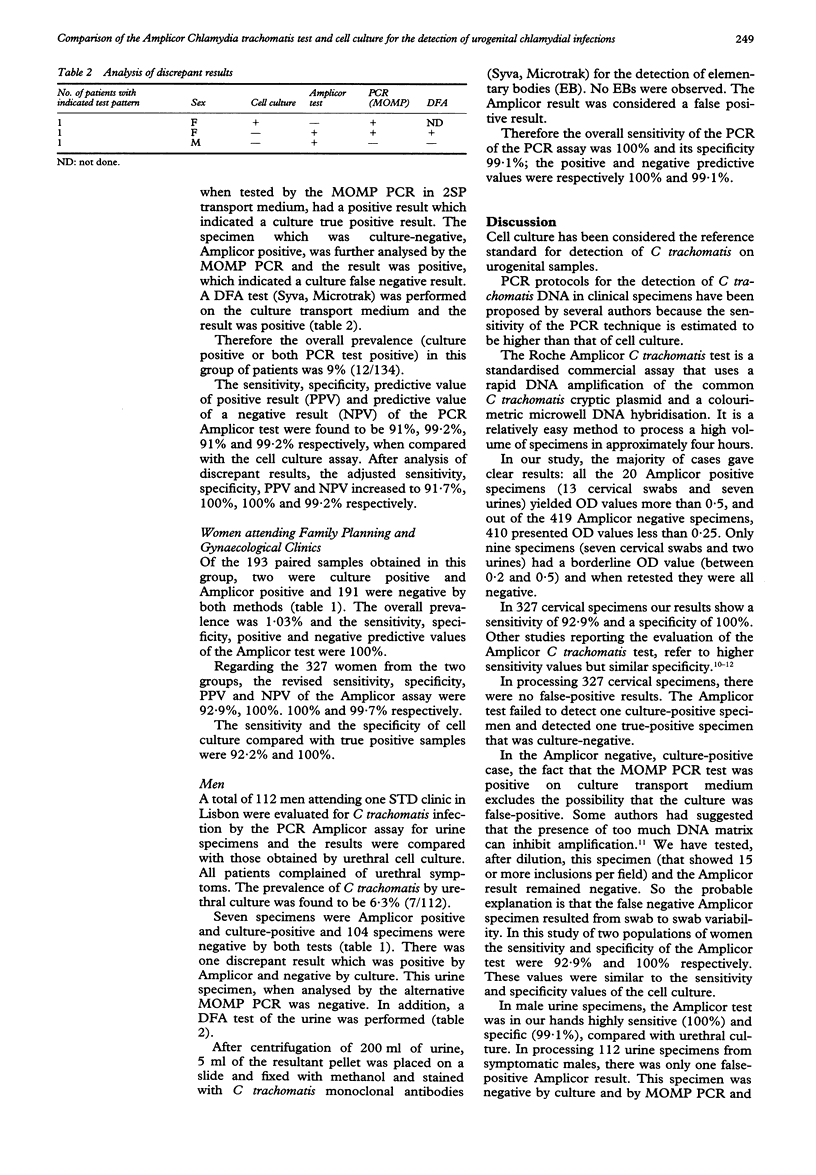Abstract
OBJECTIVE--To compare the polymerase chain reaction (PCR) Amplicor Chlamydia trachomatis test with the cell culture method, in diagnosing urogenital chlamydial infections. SUBJECTS--439 patients (327 women and 112 men) attending one STD clinic and Family Planning and Gynaecological Clinics in Lisbon, Portugal, between November 1993 and March 1994. METHODS--In women, two endocervical swab samples were collected: one for PCR Amplicor and one for standard culture technique. Men were asked to submit 20 ml of urine (first pass urine) for PCR Amplicor and one urethral specimen was taken for culture. The order of collection of the specimens was rotated every 50 patients. Discrepant results were further analysed by a second PCR with primers directed against the C trachomatis major outer membrane protein (MOMP) and by direct fluorescent antibody (DFA). RESULTS--After analysis of discrepancies, the adjusted sensitivity and specificity of PCR on endocervical specimens were 92.9% and 100% and the positive and negative predictive values were 100% and 99.7% respectively; on the urine samples these values were 100%, 99.1%, 100% and 99.1%, respectively. CONCLUSION--These results indicate that the PCR Amplicor test is a rapid sensitive and specific assay for the detection of C trachomatis in urogenital infections and provides a non-invasive technique for screening chlamydia infection in men.
Full text
PDF



Selected References
These references are in PubMed. This may not be the complete list of references from this article.
- Dutilh B., Bébéar C., Rodriguez P., Vekris A., Bonnet J., Garret M. Specific amplification of a DNA sequence common to all Chlamydia trachomatis serovars using the polymerase chain reaction. Res Microbiol. 1989 Jan;140(1):7–16. doi: 10.1016/0923-2508(89)90053-3. [DOI] [PubMed] [Google Scholar]
- Griffais R., Thibon M. Detection of Chlamydia trachomatis by the polymerase chain reaction. Res Microbiol. 1989 Feb;140(2):139–141. doi: 10.1016/0923-2508(89)90047-8. [DOI] [PubMed] [Google Scholar]
- Jaschek G., Gaydos C. A., Welsh L. E., Quinn T. C. Direct detection of Chlamydia trachomatis in urine specimens from symptomatic and asymptomatic men by using a rapid polymerase chain reaction assay. J Clin Microbiol. 1993 May;31(5):1209–1212. doi: 10.1128/jcm.31.5.1209-1212.1993. [DOI] [PMC free article] [PubMed] [Google Scholar]
- Loeffelholz M. J., Lewinski C. A., Silver S. R., Purohit A. P., Herman S. A., Buonagurio D. A., Dragon E. A. Detection of Chlamydia trachomatis in endocervical specimens by polymerase chain reaction. J Clin Microbiol. 1992 Nov;30(11):2847–2851. doi: 10.1128/jcm.30.11.2847-2851.1992. [DOI] [PMC free article] [PubMed] [Google Scholar]
- Ossewaarde J. M., Rieffe M., Rozenberg-Arska M., Ossenkoppele P. M., Nawrocki R. P., van Loon A. M. Development and clinical evaluation of a polymerase chain reaction test for detection of Chlamydia trachomatis. J Clin Microbiol. 1992 Aug;30(8):2122–2128. doi: 10.1128/jcm.30.8.2122-2128.1992. [DOI] [PMC free article] [PubMed] [Google Scholar]
- Ratti G., Moroni A., Cevenini R. Detection of Chlamydia trachomatis DNA in patients with non-gonococcal urethritis using the polymerase chain reaction. J Clin Pathol. 1991 Jul;44(7):564–568. doi: 10.1136/jcp.44.7.564. [DOI] [PMC free article] [PubMed] [Google Scholar]
- Sayada C., Denamur E., Orfila J., Catalan F., Elion J. Rapid genotyping of the Chlamydia trachomatis major outer membrane protein by the polymerase chain reaction. FEMS Microbiol Lett. 1991 Sep 15;67(1):73–78. doi: 10.1016/0378-1097(91)90447-i. [DOI] [PubMed] [Google Scholar]
- Vogels W. H., van Voorst Vader P. C., Schröder F. P. Chlamydia trachomatis infection in a high-risk population: comparison of polymerase chain reaction and cell culture for diagnosis and follow-up. J Clin Microbiol. 1993 May;31(5):1103–1107. doi: 10.1128/jcm.31.5.1103-1107.1993. [DOI] [PMC free article] [PubMed] [Google Scholar]
- Wu C. H., Lee M. F., Yin S. C., Yang D. M., Cheng S. F. Comparison of polymerase chain reaction, monoclonal antibody based enzyme immunoassay, and cell culture for detection of Chlamydia trachomatis in genital specimens. Sex Transm Dis. 1992 Jul-Aug;19(4):193–197. doi: 10.1097/00007435-199207000-00002. [DOI] [PubMed] [Google Scholar]
- de Barbeyrac B., Pellet I., Dutilh B., Bébéar C., Dumon B., Géniaux M., Bébéar C. Evaluation of the Amplicor Chlamydia trachomatis test versus culture in genital samples in various prevalence populations. Genitourin Med. 1994 Jun;70(3):162–166. doi: 10.1136/sti.70.3.162. [DOI] [PMC free article] [PubMed] [Google Scholar]


